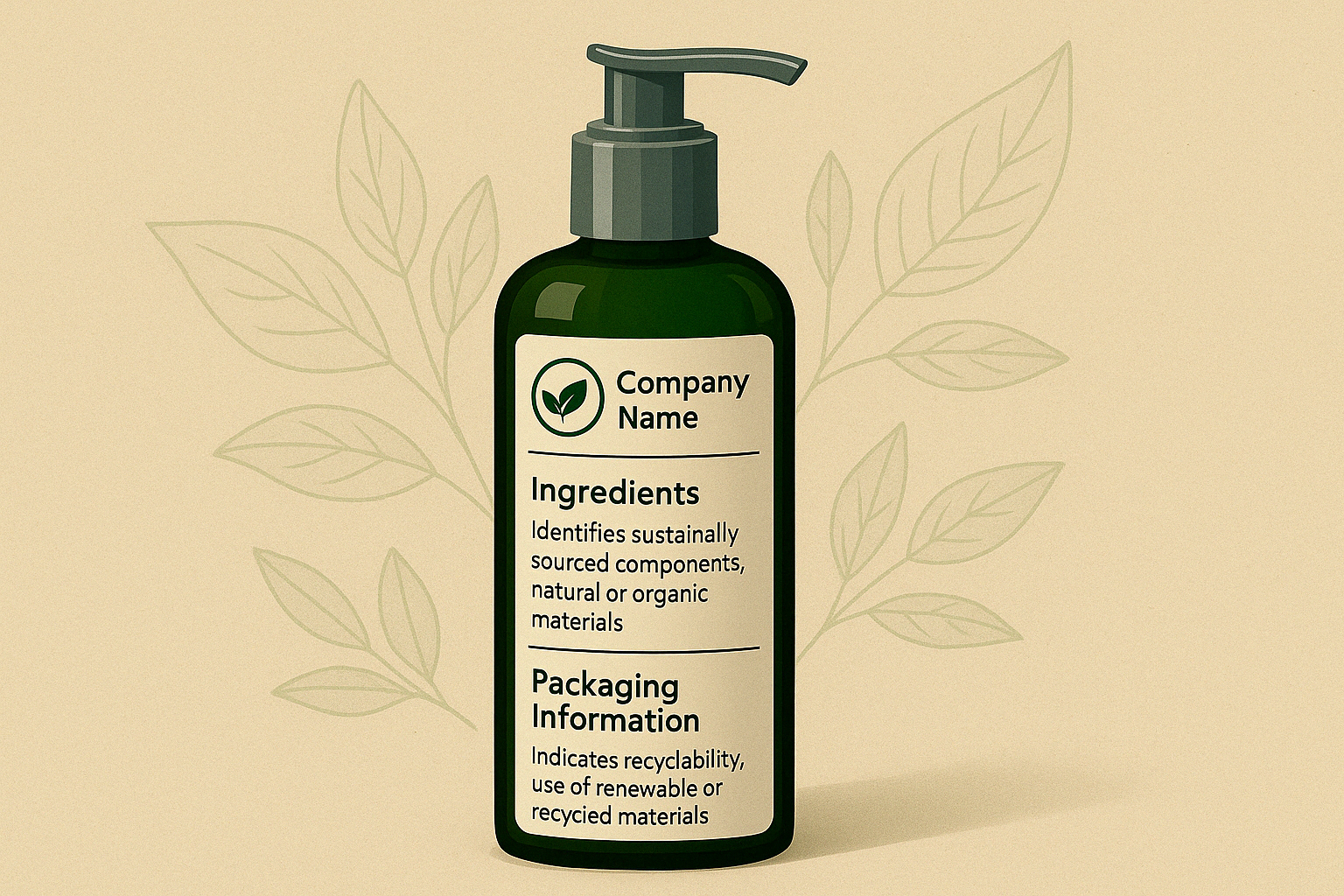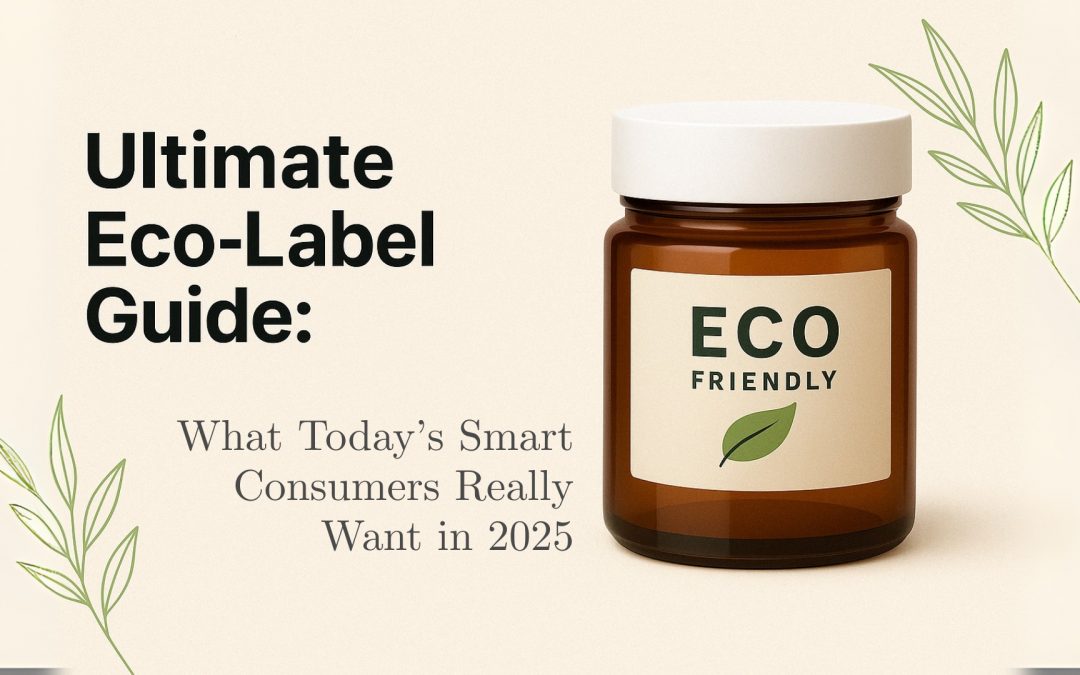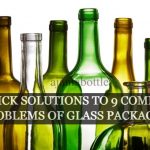In today’s increasingly eco-conscious marketplace, product labels have become more than just informative—they are now a powerful reflection of a brand’s values and environmental commitment. As consumers become more mindful of what they buy, how it’s made, and who made it, eco-labels have emerged as key decision-making tools.
No longer limited to niche or premium product lines, eco-labels are now expected across mainstream categories—from food and beverages to cosmetics, textiles, packaging, and cleaning products.
But what exactly makes a label “eco”? And more importantly, what do modern consumers actually want to see on it?
Eco-labeling, at its core, is about providing transparent, credible, and verifiable environmental information. It helps distinguish genuinely sustainable products from those that merely appear green—a distinction that is becoming crucial in an age of rampant greenwashing. With terms like “natural,” “eco-friendly,” and “sustainable” being thrown around liberally (often without supporting data), buyers are growing skeptical.
They’re no longer satisfied with vague promises. Instead, they’re looking for facts, certifications, and storytelling that resonates with both their values and their logic.
The demand for clarity is not just a passing trend—it’s a generational shift. Millennials and Gen Z are leading the way, placing immense importance on transparency, ethical sourcing, and accountability. They want to know where a product comes from, how it impacts the planet, and whether the brand behind it is truly walking the talk.
This makes eco-labeling a strategic opportunity for brands to build trust, foster loyalty, and differentiate themselves in a saturated market.
In this blog, we dive deep into the eco-labeling landscape—exploring what it means, how it influences consumer psychology, the specific features today’s shoppers expect, common pitfalls to avoid, and how packaging and labeling can work together to tell a powerful sustainability story. We’ll also take a look at the future of eco-labels as they evolve with technology, regulation, and consumer demand.
Eco-labeling isn’t optional anymore. It’s expected—and it’s transforming the way brands communicate responsibility.

1. Understanding Eco-Labeling: What It Is and Why It Matters
Eco-labeling is the practice of marking products with labels that certify their environmental impact or sustainability credentials. These labels help consumers quickly identify products that meet certain ecological standards, enabling informed, environmentally conscious purchasing decisions.
As sustainability becomes a priority for individuals and institutions alike, eco-labels bridge the gap between responsible production and responsible consumption.
Eco-labels fall into three main categories:
- Type I: These are certified labels, granted by independent third-party organizations. They follow strict standards and typically include seals such as FSC (Forest Stewardship Council), USDA Organic, and EU Ecolabel.
- Type II: These are self-declared labels created by manufacturers themselves. While these may be accurate, they are not independently verified and can be subjective or inconsistent.
- Type III: These offer quantified environmental data verified by a third party, often in the form of environmental product declarations (EPDs).
A key challenge in eco-labeling is distinguishing it from greenwashing, which refers to deceptive marketing tactics that make a product appear more environmentally friendly than it actually is. Unlike greenwashing, legitimate eco-labeling relies on transparency, data, and verification.
Eco-labeling matters across environmental, ethical, and consumer dimensions. It empowers buyers to support sustainable brands, pushes companies to improve their practices, and plays a part in broader ecological goals like reducing carbon emissions and waste. With rising consumer awareness, eco-labeling is not just a trend—it’s a necessity.
2. The Psychology Behind Eco-Labels: Why They Influence Buying Decisions
The power of eco-labels lies not just in facts, but in feelings. They tap into deep-seated emotional triggers like guilt, pride, and responsibility. When a consumer sees an eco-label, it offers a sense of assurance: “I’m making a better choice.” This moral gratification leads to stronger brand loyalty and a willingness to pay more for perceived ethical value.
Trust and brand image play a huge role. Consumers are more likely to choose a lesser-known brand if its eco-label is verifiable and aligns with their personal values. A clear, well-known certification like Fair Trade or USDA Organic can instantly boost credibility.
There’s also the appeal of “doing good” through everyday purchases. With climate change, biodiversity loss, and pollution becoming personal concerns, buyers feel empowered when their shopping habits contribute to solutions. Eco-labels make that impact tangible.
And the emotional benefit isn’t limited to personal pride—many consumers enjoy the social value of supporting a visibly ethical brand. They’re more likely to recommend such products to peers, post about them on social media, and consider them part of their identity.
Millennials and Gen Z, in particular, are driving this shift. They actively seek transparency and accountability from the brands they support. According to multiple global studies, these generations value sustainability so much that they are willing to boycott brands that lack it. They’re digital natives who research, compare, and even scrutinize label claims online.
Visual cues play an equally vital role. The presence of green tones, nature-inspired symbols (leaves, water drops), and minimalist design can trigger instant positive associations. Eco-labels aren’t just informational; they are emotional touchpoints that shape how consumers perceive and engage with products.
3. What Today’s Consumers Want to See on an Eco-Label
✅ Clarity Over Vagueness
Consumers today expect specificity. Terms like “eco-friendly” or “green” are no longer enough. Buyers want to see clear, measurable claims such as “100% recyclable material,” “Made from 80% post-consumer waste,” or “Compostable within 60 days.” Vague marketing language creates skepticism and erodes trust.
✅ Third-Party Certifications
Trusted certifications are top-of-mind for today’s conscious consumer. Labels such as:
- FSC (Forest Stewardship Council)
- USDA Organic
- Fair Trade Certified
- GOTS (Global Organic Textile Standard)
…are not only credible but also easily recognizable. These third-party verifications add legitimacy to environmental claims and differentiate a brand in a crowded marketplace.
✅ Carbon Footprint Information
As climate consciousness rises, consumers are demanding transparency about a product’s carbon emissions, from manufacturing to delivery. Eco-labels that state “Carbon Neutral Product” or display a specific carbon footprint value (“e.g., 2.3 kg CO2e”) empower buyers to consider environmental impact at a glance.
✅ Traceability Tools
Modern consumers want to know where products come from. Labels that incorporate QR codes, NFC tags, or even blockchain-based tracking systems offer real-time transparency about sourcing, labor, and materials. It transforms packaging into an interactive, informative experience.
✅ Material Origin & Ethical Sourcing
Information about the origin of raw materials, such as “Glass sourced from recycled post-industrial waste” or “Cocoa grown under fair labor conditions in Ghana”, appeals to both ethical and environmentally concerned audiences. It adds depth to the product story and signals brand integrity.

4. Common Pitfalls and Misleading Practices in Eco-Labeling
Not all eco-labels are created equal. Many fall short by relying on vague, misleading, or unverified claims that confuse or mislead consumers.
The most common issue is the overuse of buzzwords like “green,” “eco-safe,” or “natural,” which have no regulatory backing. These terms are attractive but often lack substance, and without verification, they risk being perceived as greenwashing. In some cases, brands use them to capitalize on consumer goodwill while doing little to reduce their environmental impact.
Another frequent pitfall is ambiguous labeling with no certification. Claims like “sustainable choice” or “environmentally responsible” without third-party verification offer little value or reassurance.
Visual manipulation is also a concern. Packaging designed with green color palettes, leaves, or earthy textures may give the illusion of sustainability without actual eco-friendly practices behind it. This design-centric deception is subtle but powerful, especially when consumers are time-pressed or not fully informed.
Many brands make temporary environmental claims, such as using recycled materials for one campaign, without a long-term commitment to sustainability. This inconsistency can backfire, leading to consumer distrust and skepticism toward other brands with legitimate practices.
Ultimately, misleading eco-labeling damages not just the brand but the broader sustainability movement. It undermines consumer confidence and makes it harder for genuinely responsible brands to stand out in an already crowded market.
5. Aligning Eco-Labeling with Packaging and Brand Storytelling
An eco-label should never exist in isolation. It must be part of a holistic brand narrative, starting with the product and extending to the packaging itself. Today’s consumers expect packaging to mirror the sustainable promises made on the label.
For instance, using an eco-label on a product packaged in non-recyclable plastic immediately causes brand disconnect. In contrast, a biodegradable pouch with a clearly labeled compostable seal demonstrates commitment across the board.
There are many examples of clean, effective eco-labeled packaging:
- Glass jars with etched labels for zero-waste impact
- Minimalist packaging with QR code-based ingredient traceability
- Frosted or matte bottles that avoid excess dyes and inks
Customizable packaging with smart labels like AR or QR code integration is on the rise. These tools can lead consumers to extended content like sourcing stories, sustainability pledges, or third-party audit reports.
Eco-labels also serve as powerful brand storytelling devices. Instead of just saying “we care,” brands can show how they care—be it by revealing their energy savings, ethical workforce, or waste reduction achievements.
Finally, material transparency is essential. Statements like “Made from recycled aluminum” or “Compostable sugarcane-based liner” build consumer confidence and reinforce authenticity. When packaging, labeling, and storytelling align, the message is more convincing and memorable.
6. The Future of Eco-Labeling: From Trust Marks to Smart Labels
As consumer expectations evolve, the future of eco-labeling is becoming smarter, more transparent, and increasingly digital. Brands are moving beyond static trust marks to adopt interactive eco-labels that inform, educate, and engage.
One major trend is the use of digital packaging tools like dynamic QR codes, which adapt based on geography, batch information, or sustainability updates. These enable real-time storytelling and traceability, giving consumers a deeper connection with the product lifecycle.
AI-powered product insights are also emerging. Imagine scanning a label and receiving a breakdown of the product’s environmental impact, social compliance, and carbon score—automatically tailored to the user’s preferences or region.
Governments and advocacy groups are calling for greater standardization of eco-labels across industries and countries to reduce consumer confusion. Regulatory frameworks may soon require uniform labeling structures, verified databases, or centralized registries for environmental claims.
A notable shift is the integration of ESG (Environmental, Social, and Governance) metrics into product-level labels. Brands can no longer rely on siloed sustainability claims; consumers want to see the full picture of impact.
Finally, the role of education is crucial. Brands must not only adopt smart labeling but also guide consumers on how to interpret and use them. An informed buyer is more likely to make sustainable choices, creating a ripple effect across the market.
The future of eco-labeling isn’t just about saying you’re green. It’s about proving it—transparently, intelligently, and interactively.
Conclusion
Eco-labeling has moved far beyond simple tags and seals; it has evolved into a dynamic system of communication between brands and consumers. In a world where sustainability is not just valued but expected, eco-labels have become a symbol of accountability, trust, and genuine environmental action. They serve as silent storytellers, educating and empowering consumers to make better, more responsible choices.
Today’s consumers are no longer content with vague claims or decorative green designs. They want clarity, verification, and a deeper understanding of the products they bring into their homes and lives. Whether it’s through third-party certifications, carbon footprint disclosures, or interactive traceability tools, brands must go the extra mile to earn and maintain trust.
At the same time, brands must recognize that eco-labeling is not a one-time achievement. It is a continuous journey that demands innovation, consistency, and alignment with every aspect of the product—from sourcing and manufacturing to packaging and marketing.
Looking ahead, eco-labeling will be shaped by technology, regulation, and a growing consumer desire for meaningful transparency. Smart labels, integrated ESG metrics, and global standardization are all on the horizon. But beyond tools and data, the real power lies in education and intent. Brands that use eco-labeling not just as a sales tactic but as a core value proposition will thrive in this new landscape.
In the end, eco-labeling is more than a marketing tool—it’s a commitment to the planet, to people, and to a better, more informed future. The question is no longer whether to adopt eco-labeling, but how boldly and authentically you’ll lead with it.

Read Also:
- Beauty for All: Why Gender-Neutral Packaging Is Popular in 2025: https://www.ajantabottle.com/blog/gender-neutral-beauty-packaging/
-
Beyond the Bottle: 7 Ways to Add Flair to Glass Bottle Decoration: https://www.ajantabottle.com/blog/7-glass-bottle-decoration-ideas/
Need some amazing and eye-catching Packaging Solutions for your products?
Contact our packaging advisors today to learn more about our products and services, and to address any question/query.
Connect with us:
Email at sales@ajantabottle.com
Phone/Whatsapp: +91 9891098918
You can also shop from more than 500+ packaging solutions on www.ajantabottle.com – India’s first ever comprehensive packaging e-commerce portal.
For additional information, browse through our blog at https://www.ajantabottle.com/blog/ or subscribe to our latest updates through our social media channels,
*YouTube channel: https://www.youtube.com/c/Ajantabottle
*LinkedIn Page: https://www.linkedin.com/company/ajantabottle
*Facebook Page: https://www.facebook.com/glassbottleindia
*Instagram Page: https://www.instagram.com/ajantabottle/
*Google Business Profile Manager: https://g.page/r/CXTH9MKpe2DuEBM/review





